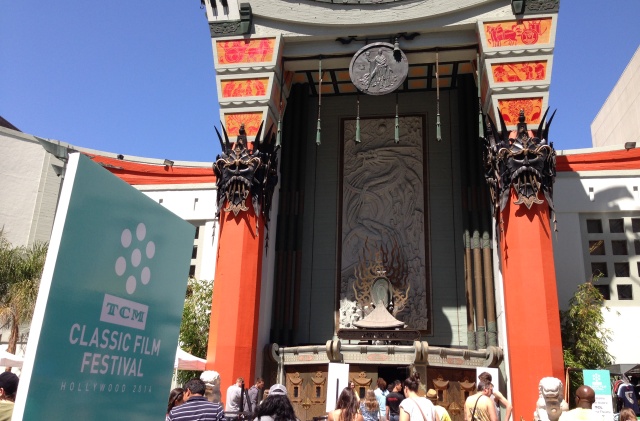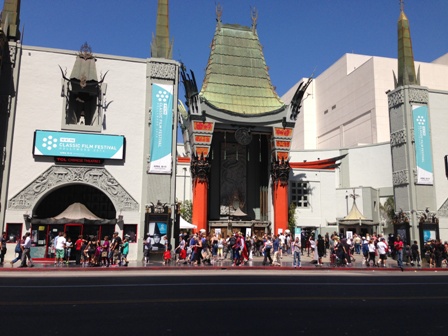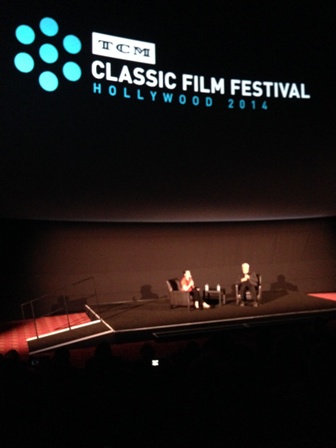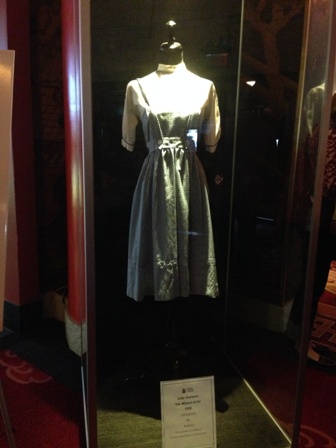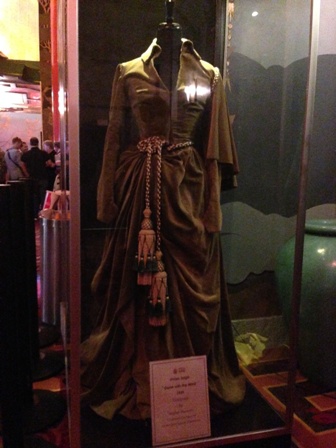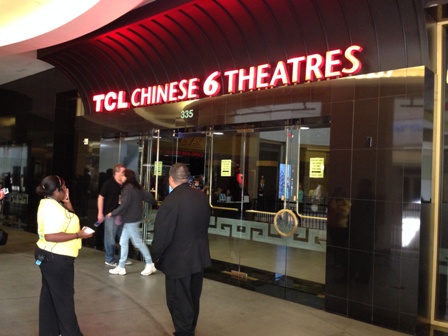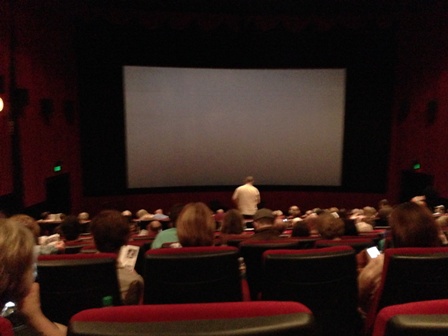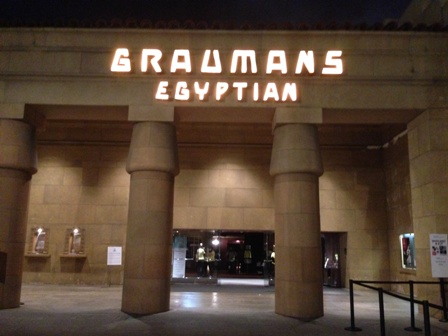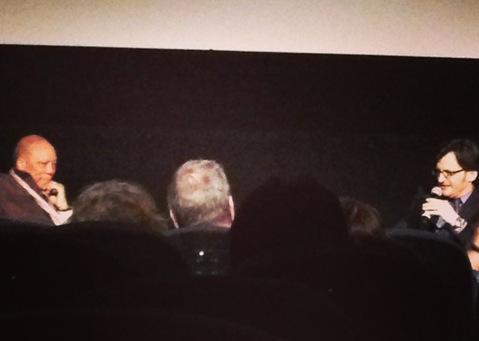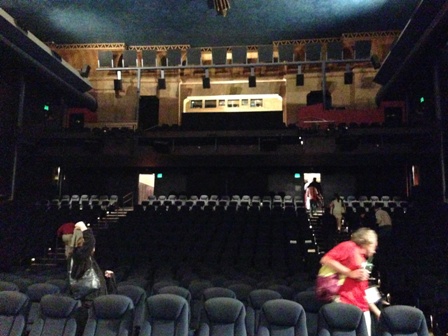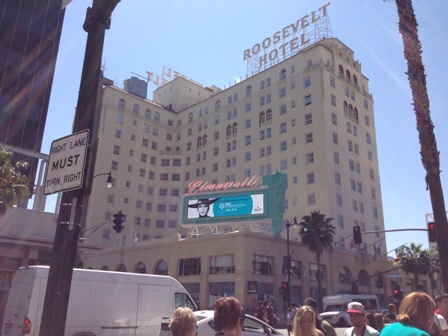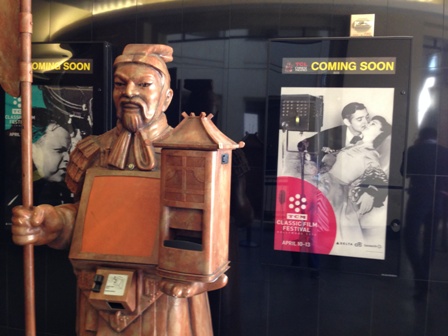Film Festivals are usually set up to show off the talents of contemporary artists and the rising stars of tomorrow. But, rarely do you see one that focuses entirely on the past. Located right in the center of Hollywood itself, the Turner Classic Movies channel (TCM) is currently showcasing it’s 5th annual Classic Film Festival. The festival is held every year in April and it features presentations of some of cinema’s greatest classics on the big screen, along with special appearances from a few Hollywood legends. It’s a special treat for anyone living in the Los Angeles area, including myself, and I made an effort this year to have the full experience in order to share my thoughts with you, my readers. First of all, I should say that one of the best things about this film festival is that it’s very easy for anyone to experience. Unlike other prestigious industry film festivals, this one is more friendly to the casual viewer and for only $20 a ticket ($10 with a student ID), you have a good chance of getting into one of the many screenings. Priority seating does go to people who have purchased the full festival passes, which run between $250 to $1500, but there is always a standby line outside the theater for everyone else, and usually those waiting in line do get in. Suffice to say, this is what I did, and it was still worth the $20 a ticket price every time. I managed to fit in three screenings throughout the day and the best part is that every experience was unique.
Since the festival is sponsored by the TCM, it’s not surprising that the faces of the channel were there in attendance as well. Hosts Robert Osbourne and Ben Mankiewicz were on hand to introduce the movies throughout the day, as well as to conduct pre-screening interviews with the many special guests in attendance. Also making appearances at the festival were film critics like Time Magazine’s Richard Corliss and Leonard Maltin, among others, who were also there to conduct interviews with the special guests. All together, the presences of the hosts and guests is what sets this festival apart from others. Not only are you getting to see classic movies on the big screen once again, but you also get the opportunity to see some of the people involved in their making up close and in person, sharing their own experiences. Some of the most noteworthy people in attendance at this year’s festival have been Quincy Jones, Mel Brooks, Richard Dreyfuss, Jerry Lewis, and Maureen O’Hara. A couple years ago, I managed to get into a screening of 20,000 Leagues Under the Sea (1954) with Kirk Douglas himself at the theater, which was remarkable and shows just how special an event like this can be, because it lets us the audience see many of these great legends of cinema before they are all gone. This year was no different, and what follows is a breakdown of my day at the festival.
The day started for me right at the heart of the festival at what is pretty much the world’s most famous movie theater, the iconic Chinese Theater. Built in 1927, and home to some of the most famous world premieres in Hollywood’s history, the theater is like a living museum and it still has the ability to wow newcomers all these years later. With a film festival happening this week, along with the sunny California weather, foot traffic was pretty heavy this weekend on Hollywood Boulevard, so getting to the theater was a hassle at times. My first screening took place in the Chinese at it was the classic Vincente Minnelli musical Meet Me in St. Louis (1944). It was a movie that I hadn’t seen before (odd, right?) and I was determined this year to watch films that were new to me, so this one seemed like a logical choice. Plus, it allowed me to experience the Chinese Theater once again, which has gone through a full remodel in the last year, changing the old theater into a modern, stadium seating IMAX venue. The remodel was beautifully done, and still manages to keep the original integrity of the theater’s ornate artistry; including the stunning ceiling centerpiece.
Below the impressively giant screen was a small stage platform set up for the pre-screening interview. Richard Corliss of Time Magazine walked out to greet us before the movie began and gave us a brief overview of the film’s production and legacy. After his short introduction, he welcomed to the stage actress Margaret O’Brien, who played one of the key roles in the movie. Margaret was a perfect choice of guest for this screening, because of her own on set experience, and she had a wealth of stories to tell, which is remarkable given that the movie is celebrating it’s 70th anniversary this year, and she was only a little girl when she was making it. She talked about performing alongside the legendary Judy Garland, working with Vincente Minnelli, and how they managed to make her cry believably on film. The interview was short, but nonetheless very worthwhile, and it certainly opened up our eyes in the audience to things we probably wouldn’t have noticed before, had we not heard it from Margaret O’Brien beforehand. I particularly liked this interview portion, because she explained very well the experience of being a child actor in that era, and she shared her memories very well, including the knowledge that she acted alongside the late Mickey Rooney recently on what will be his last film. The movie itself was fine enough for a first viewing (not much of a musical fan here), but it was a good start to the day.
In the lobby of the Chinese Theater was a special treat for film buffs. Enclosed in glass displays were some original costumes loaned out from various studio archives. One of the most popular was Dorothy’s blue dress from The Wizard of Oz (1939), which readily had a line in front of it for pictures after the screening was over. I, of course, didn’t waste the opportunity either. It was a great added treat for film buffs like me. Elsewhere in the lobby, I also found a dress worn by Julie Andrews in Thoroughly Modern Millie (1967), the famous curtains dress Vivian Leigh wore in Gone With the Wind (1939) (which made me instantly think of the gag version Carol Burnett wore on her show), as well as some new costumes from the movie Noah (2014), which is still in theaters. Displays like these were very welcome, but sadly not very extensive. I would’ve loved to have seen a full gallery display somewhere at the festival for film memorabilia of all kinds, but I guess with an event being as busy as this was, it was about as good as they could do. Still, a worthwhile thing to add to the overall experience.
Of course, I still had a lot to fit in on this day, so I quickly made my way to the next screening. This one took me to the TCL Chinese 6 Theater, which is a brand new multiplex built adjacent to the legendary Chinese Theater and continues it’s same theme, but with some modern flourish. The Chinese 6 was built as part of the whole Hollywood & Highland development that included the new home of the Academy Awards, the Dolby Theater, which is literally right next door to this venue. Of the six screens in the multiplex, three were given over to the film festival for some of the screenings of the smaller and more obscure films of the festival. But, even with the smaller venue, the screenings were still treated with the same respect as the ones in the bigger theaters. The screening I caught here was for another film I had yet to see; Peter Bogdanovich’s Oscar-winning film Paper Moon (1973). Like some of the other screening’s, we were promised a pre-show interview, but unfortunately this time, our special guest was a no-show; that being the film’s star Ryan O’Neal. The volunteer staff did a good job letting us know ahead of time that Mr. O’Neal had canceled at the last minute, which does happen. Ben Mankiewicz also filled us in on the situation during his introduction, and he mentioned that he was crossing his fingers that the same thing wouldn’t happen before his big interview with Jerry Lewis before the The Nutty Professor (1963) screening the next day. Even without the special guest, it was still a nice experience seeing a classic film on the big screen for the first time, which is how it should always happen.
Once night fell, I got in line for my final screening which was going to be for Blazing Saddles (1974), with the legendary Mel Brooks in attendance. As a Mel Brooks fan, suffice to say, this was a screening that I was definitely looking forward to. Unfortunately, I experienced my first sell-out of the festival here. There weren’t enough seats left to fill with people waiting in the standby line, even with the huge venue that is the Chinese Theater. The volunteer staff recommended that we check out some of the other screenings still going on at other venues, which would start over the next hour. After checking my schedule, I noticed that the Egyptian Theater down the road was screening the classic Michael Caine film The Italian Job (1969), with composer Quincy Jones in attendance. Luckily, since it was after 9 pm, there was less sidewalk traffic, so I was able to cover the half-mile between the Chinese and the Egyptian in no time, and this screening proved to be a great alternative for the night. First of all, I had never been in the Egyptian up until now, so this was going to be something new for me, even if it was to see a movie that I had watched before. The Egyptian Theater also has it’s own storied history; it’s older than the Chinese Theater, having opened in 1922, for one thing. The theater also experienced a dramatic renovation as well, albeit removing much of the original ornate decorations in favor of a more sterile, modern look.
The highlight of the screening, however, was the pre-show interview with Mr. Quincy Jones. Ben Mankiewicz had the honors of conducting the Q & A, and it was very apparent that he was speaking to someone that he very much admired. Before the interview began, Ben introduced a special career retrospective video that played on the big screen, which beautifully laid out all the contributions that Quincy has made to both the film and music industry. Quincy Jones was brought up on stage next and the interview went into the man’s own experiences working in all facets of the entertainment industry, as well as working on a film score like the one he did for The Italian Job. Let me tell you, this man has some great stories; the interview could have gone on for hours and the whole audience would’ve still been captivated. The interview was so good, that the movie itself would’ve been a letdown if it wasn’t also a good movie. Ben Mankiewicz was also very drawn in, and he even said he wanted to go overtime a bit because he was loving Quincy’s stories so much, especially the one’s about his friendship with Frank Sinatra. Once the interview portion was over, Quincy Jones walked off stage and actually stayed to watch the movie, which some of the special guests rarely do, especially this late at night. I was excited because he took his seat only two rows ahead of where I sat, and let me tell you, he was enjoying the movie experience just as well as the rest of us. It’s special perks like that which makes this kind of film festival special and it helped to make up for missing out on seeing Mel Brooks at that Blazing Saddles showing.
Overall, these were my experiences at the TCM Classic Film Festival this year, and I can’t recommend it highly enough. For one thing, you’re watching all these classic movies in the very heart of Hollywood culture itself; at places where many of these movies had their world premieres many years ago. Secondly, you get the chance to take in a lot of film history, either by seeing a movie in one of the legendary theaters, or by attending a screening with one of the special guests in attendance. Even with all that I was able to see at the festival this year, there were still many other events that I wasn’t able to get into; and ones I couldn’t get in at all because they were exclusive to premium pass holders. Some of the other events taking place at this year’s festival were a special presentation at the Chinese Theater commemorating a new postage stamp in honor of actor Charlton Heston, with his son Fraser in attendance. There was also a special tribute held for recently deceased actor Mickey Rooney, as well as special one on one interviews held at a special area called Club TCM, located in the legendary Roosevelt Hotel, across the street from the Chinese Theater. Other venues like the Montalban Theater and the El Capitan also have featured screenings as part of the festival, which helps to give this event a very wide spread variety of things to do.
This was my third year of attending the festival and the first time I’ve ever fit in more than one screening. Like I mentioned before, the first time I came to this was for the 20,000 Leagues Under the Sea showing with Kirk Douglas in attendance (he was 95 years old at the time). The second year I caught a screening of Mel Brook’s The Twelve Chairs (1970), which Mr. Brooks was also present; which made my sell-out the other night not as painful as it could have been. This year was another excellent year for the festival and I hope that it continues to stay popular for years to come. It’s especially worthwhile for anyone who’s a fan of classic movies and would wish to see many of the people involved in the making of these films before they are long gone. Hopefully in the future I will be able to afford one of the premium passes available, so that I can get better access to all the different events and see more of the movies. The festival is still going on now through Saturday and Sunday, and it will return the following April with a whole new line-up of films and honored guests. If you live in the LA area, and like classic movies, I strongly suggest you make your way to Hollywood now and enjoy this special gift to classic movie fan-dom.
